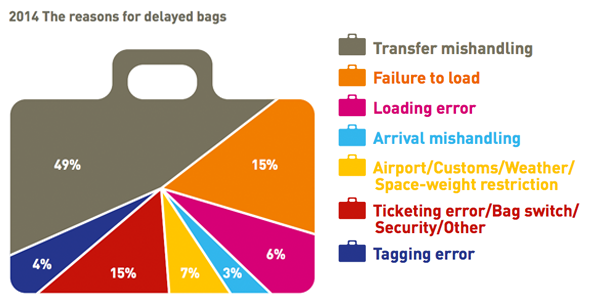
The annual SITA Baggage Report has just been released and it shows that 7.3 bags per 1,000 were mishandled in 2014; a slight increase on the 6.96 per 1,000 recorded in 2013, when annual passenger numbers were 5.5% lower.
The positive news, however, is that the rate of mishandled bags has been cut by 61.3% globally since 2007, when 18.8 bags per 1,000 were mishandled. These improvements over the past seven years have created cost savings of an estimated $18 billion for the industry.
In 2014, around four in five (80.2%) mishandled bags were delayed, 14.3% of the bags were damaged or pilfered, and 5.5% were lost or stolen. The report also offers insight into the reasons behind delayed baggage in 2014. Unsurprisingly, almost half – 49% – of cases were due to transfer mishandling. In real terms, 11.81 million transfer bags were delayed in 2014.
Another key point in the report is that airlines and airports are planning to invest in more self-service options in the coming years. Around a third of airlines and airports currently offer on-airport self-tagging options, but 82% of airlines and 69% of airports expect to offer self-tagging kiosks by 2017. During the same period, the number of airports offering assisted bag drop is expected to rise from 38% to 74%, with the number of airlines offering the service rising from 33% to 86%. By 2017, 66% of airlines also plan to offer bag location updates via passengers’ mobile devices. It’s no surprise that home printed and permanent bag tags are also expected to gain traction in the coming months and years.
Commenting on the report, Francesco Violante, CEO, SITA, said: “This improvement in baggage handling over the past seven years is largely a result of strong technology investment and innovation in baggage systems automation and processes. However, rising passenger numbers will continue to place pressure on baggage infrastructure and processes, so the industry cannot afford to become complacent. With IATA forecasting continued passenger growth of around 7% in 2015, all industry partners will need to continue to invest, collaborate and focus on baggage management.”
The industry is also hoping that the introduction of IATA Resolution 753 on baggage tracking will help to cut the mishandled bag rate, although we have to wait another three years for that to come into effect.






